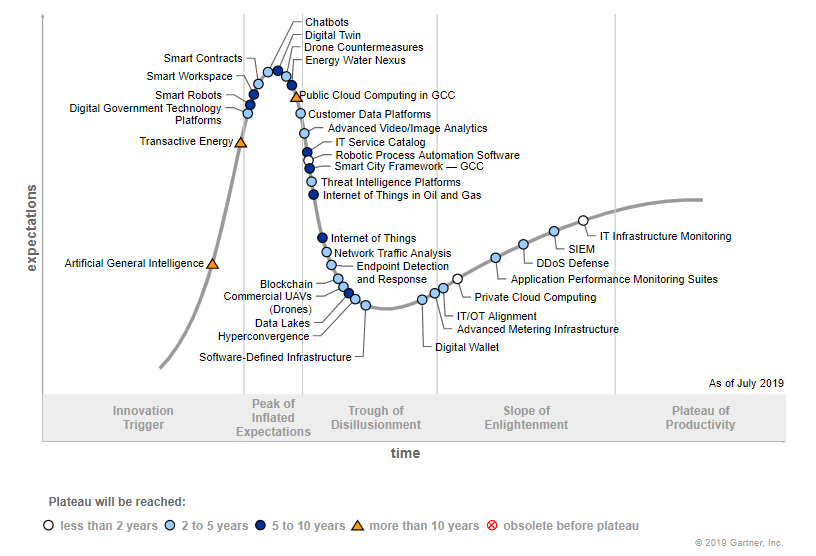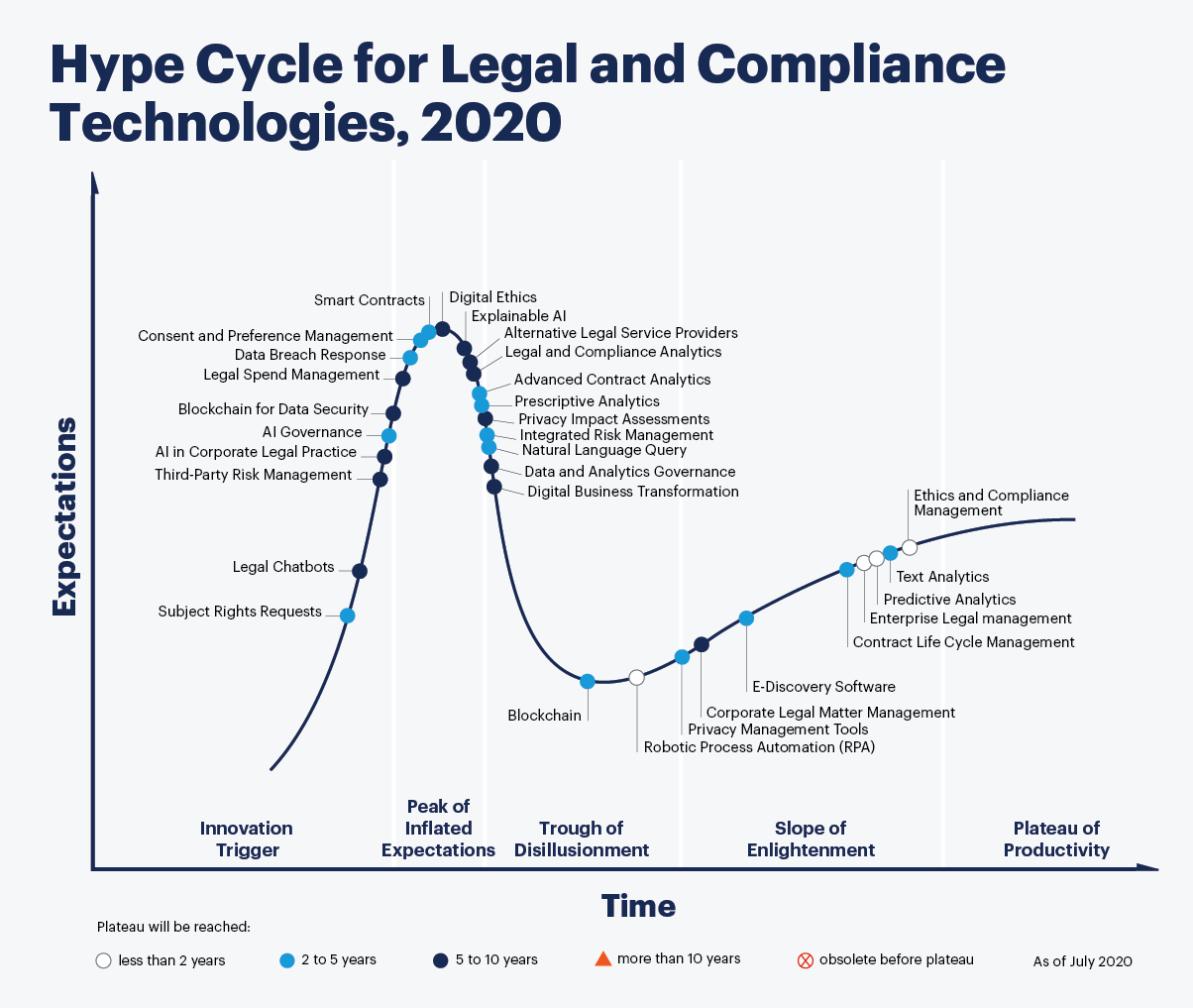Introduction
In various industries, companies like Vee Healthtek, use RPA (Robotic Process Automation) to simplify and automate critical business processes both internally and for customers every day. Many companies have successfully implemented RPA to alleviate pressure caused by staffing issues or gain general efficiencies for repetitive, labor-intensive tasks. It has been a monumental tool in gaining those efficiencies in a short amount of time and at a relatively small cost.
For example, one study conducted by Gartner looked at emerging technologies for legal and compliance leaders in 2019. The graphic shown below indicates that RPA had tremendous popularity when it came to solving issues those departments faced at that time; but the software was expected to plateau or reach a state of diminished interest, in just a couple of years (Moore, 2019 Gartner). What caused this shift? It's becoming clear there is a need to reinforce our automation strategy and not every automation effort should be handled with RPA.
Choosing to develop and implement APIs, or Application Programming Interfaces, over RPAs can simplify the automation process, enhance existing RPAs, and provides companies with an opportunity to develop new revenue streams. There comes a time when one needs to drop the RPA screwdriver and pick up the API drill.

The Dark Side of RPA
Although RPA is a fantastic tool for automating legacy applications that have no existing data integration, using RPA alone creates two distinct problems. First, it is reliant on indirect access to data through a user interface that may not always work. Additionally, RPA can complicate solutions by both creating “technical debt” and increasing maintenance costs.
When data providers update either their websites or applications, existing RPAs almost always break and require an RPA developer to intervene and update the bot to account for those changes. During this time, the tasks performed by the bot either grind to a halt or rely on human backups until the RPA bot can be patched. This approach, though successful, creates a layer of complexity that is sub-optimal.
To be proactive and fix the bots before they break, RPA developers routinely assess the third-party applications manually and the forms they automate. The problem quickly becomes apparent when we consider most RPA solutions are not reusable; they only address a single need for a single customer. What happens when several RPAs for a client, or dozens of clients, are created? There are now hundreds of potential points of failure as each third-party application within an RPA solution needs to be individually monitored for changes; this is technical debt.
Companies trying to implement their own RPA solutions have encountered this problem and ultimately realized that RPA failed too often or required more maintenance than they were prepared to perform. This is illustrated by an updated Gartner Hype Cycle that showed that RPA was experiencing performance issues and generally not meeting ROI expectations (van der Meulen, 2020 Gartner).

The API Solution
Investing in the use of APIs will allow any company to better serve its customers by simplifying the automation process. Further, APIs can enhance existing RPA implementations by removing layers of complexity that are subject to change. Doing so vastly improves the stability and speed of RPA solutions, which would otherwise rely on a webpage to load or an application screen to refresh, a bigger problem with a poor internet connection or slow computer. While RPA gathers and inputs data many times faster than a human, an API can achieve the same goal many times faster than RPA at a fraction of the overall resource cost.
Implementing a complete API solution or as an enhancement to RPA, provides us with one simple, yet crucial advantage -- reusability. APIs are designed to connect endpoints; they are created to integrate two separate environments and provide direct access to data quickly and securely rather than scraping it from a screen. Once implemented, that same API solution can be used for other clients and services as easily as connecting a metaphorical wire. This makes API the clearly preferred long-term strategy as it has significantly lower technical debt.
Gartner states that “API-first strategies have now become the dominant strategy for software engineering leaders as they simplify application integration across their teams, across their organizations as a whole, and externally to partners and customers” (Gartner 2021). This integration strategy is key in creating and maintaining streams of revenue. “Salesforce.com generates 50% of its revenue through APIs, Expedia.com generates 90%, and eBay, 60%” (Iyer & Subramaniam, 2015 HBR).
By using APIs, organizations align themselves to provide faster, repeatable, and more accurate results. Further, they are doing so using the highest industry standards which makes it easier to serve larger, more tech-savvy and security conscience clients. As of 2021, RPA is no longer on Gartner’s hype cycle. Why? According to Gartner, “[legal and compliance] leaders should consider automation capabilities increasingly offered as part of core legal and compliance technologies” (Hutto & Audet, 2021 Gartner). In other words, use software that eliminates the need for RPA. Those recommended software packages, not coincidentally, are built using APIs.
Conclusion
RPA is a good fix for an immediate need and still has its place in any company’s automation strategy. However, it is not an ideal long-term strategy. By making use of APIs, organizations can gain access to key data elements directly, enabling the production of complete automation solutions rather than temporary, partially automated ones, all while gaining efficiency, lowering costs, and paving the path for extraordinary outcomes.
Works Cited:
Hutto, Z., & Audet, C. (2021, July 19). Hype cycle for legal and Compliance Technologies, 2021. Gartner. Retrieved July 13, 2022, from https://www.gartner.com/en/documents/4003713
Iyer, B., & Subramaniam, M. (2015, January 7). The strategic value of apis. Harvard Business Review. Retrieved July 14, 2022, from https://hbr.org/2015/01/the-strategic-value-of-apis
Moore, S. (2019, October 17). Top trends from Gartner Hype Cycle for Digital Government Technology 2019. Gartner. Retrieved July 13, 2022, from https://www.gartner.com/smarterwithgartner/top-trends-from-gartner-hype-cycle-for-digital-government-technology-2019
van der Meulen, R. (2020, October 5). Gartner identifies the legal and compliance technologies to focus on post covid-19. Gartner. Retrieved July 13, 2022, from https://www.gartner.com/en/newsroom/press-releases/2020-10-05-gartner-identifies-the-legal-and-compliance-technologies-to-focus-on-post-covid-19
